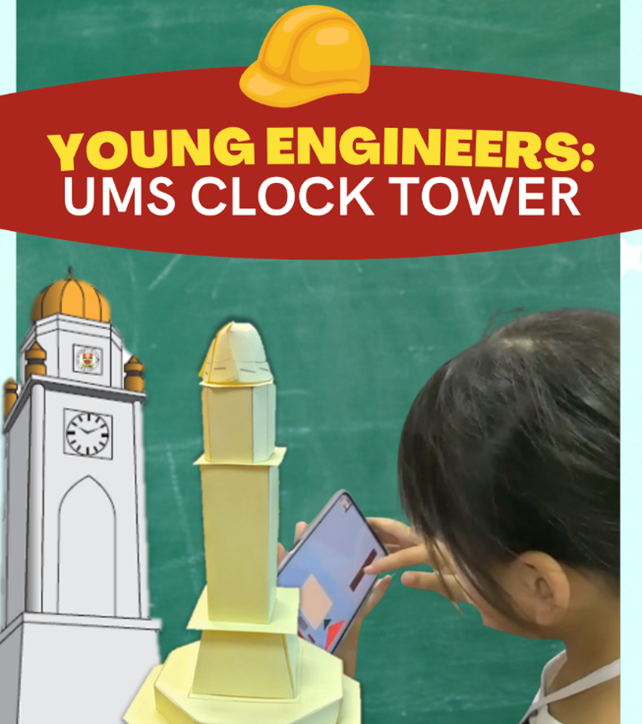 Author: Dr. Connie Cassy Ompok
Author: Dr. Connie Cassy Ompok
Faculty of Psychology and Education, Universiti Malaysia Sabah
This email address is being protected from spambots. You need JavaScript enabled to view it.
In response to The Star article dated Saturday, February 17, 2024, titled "Put Out More Lucrative Offers to Keep Local Engineers," Malaysian stakeholders emphasized the necessity of offering more competitive incentives to retain local engineers.
As some Malaysian engineers are lured abroad by superior salary packages and others opt to leave the sector entirely, concerted efforts are deemed imperative to bolster the domestic engineering workforce.
In 2014, Universiti Malaysia Sabah (UMS) achieved a significant milestone by becoming the first Public Higher Learning Institution to erect a clock tower on its campus. Standing at a height of 9 meters, the clock tower was situated at the heart of the UMS roundabout, poised to become a prominent landmark and source of pride for the UMS community.
During the inauguration ceremony, the Vice-Chancellor, Prof. Datuk Dr. Mohd. Harun Abdullah, emphasized the symbolic significance of the UMS clock tower, highlighting its representation of the value of time for intellectuals and scholars.
He stressed its role in instilling the discipline of time management not only among students but also among the staff of UMS. The construction of the UMS Clock Tower coincided with the university's 20th anniversary, making it an iconic symbol of this milestone.
Inspired by the vision of the 4th vice-chancellor, the concept was translated into an artistic form at the Concept Idea stage.
The original design concept was crafted by Suhaimi Latip, a Senior Architect Assistant at JPP, and further developed and brought to fruition through Corporate Social Responsibility (CSR) efforts by BHO MELATI.
Uniqueness of UMS Clock Tower in Children Learning
According to Prof. Emeritus Dato’ Dr. Noraini Idris, the appeal of incorporating geometric foundations into early childhood education, emphasizing the importance of using the environment to facilitate learning.
It underscores the necessity of utilizing visuals, various shapes, and hands-on activities to engage young learners. Furthermore, it highlights the significance of STEM education in fostering critical thinking and reasoning skills from an early age, thereby laying the groundwork for lifelong learning.
STEM education is praised for promoting collaboration and knowledge-sharing among educators and students, thereby enriching their educational experiences. The statement also stresses the relevance of STEM skills, such as critical thinking, creativity, and collaboration, in today's job market. These skills complement 21st-century competencies like communication and literacy, empowering students to tackle real-world challenges and innovate solutions, thus enhancing their adaptability and competitiveness.
The statement advocates for a teaching approach that integrates Science, Technology, Engineering, and Math through hands-on activities, aiming to spark greater interest in STEM subjects among learners. It enumerates the benefits of STEM education for students, including enhanced critical thinking skills, preparation for future careers, improved technological literacy, promotion of innovation and creativity, emphasis on teamwork and collaboration, and enhancement of career readiness (Noraini, Ompok, Ling & Tambagas, 2019).
The Young Engineers
The Young Engineers program, centered around the UMS Clock Tower, represents an innovative approach to nurturing informal engineering skills in young children. Utilizing the UMS Clock Tower as a tool for assessment, this program concentrates on several crucial aspects of engineering that have been identified through a comprehensive literature review.
The Young Engineers program at the UMS Clock Tower is crafted to provide learners with the opportunity to put their classroom-acquired engineering skills into practice. By integrating basic technology and engineering elements, this initiative encourages participants to devise creative and innovative solutions for real-world challenges. Through engaging in both minds-on and hands-on activities, students can actively explore and develop practical problem-solving abilities.
The program's objective is to cultivate learners' engineering skills while also bolstering their problem-solving abilities, computational thinking, design thinking, creativity, communication, collaboration, data literacy, and computer science proficiency.
Children as Engineers
Utilizing the UMS Clock Tower as a focal point, children can be introduced to the fundamentals of engineering. They will discover the individuals behind the design and construction of the UMS Clock Tower, gaining insights into the step-by-step design process as they engage in activities to construct miniature versions of the tower using various shapes. This hands-on approach not only fosters their creativity but also hones their critical thinking skills.
As the demand for STEM education continues to rise, there is an increasing need for highly qualified STEM educators who can proficiently teach these subjects. Empowering more young individuals to pursue engineering and related fields can contribute significantly to fulfilling this demand. Introducing young engineers through the UMS Clock Tower initiative necessitates specialized skills and knowledge that may not be commonly possessed by traditional educators. By fostering the development of more young engineers, we can enhance the quality of STEM education, ensuring that students receive the most comprehensive and effective learning experiences possible.
The series of dissections commences with a two-piece game and progresses to three, then four-piece games. At each stage, children are tasked with "fixing" the pieces of paper (reconstructing the original square), forming shapes with the pieces, and identifying the shapes they create.
The involvement of young engineers through the UMS Clock Tower initiative contributes to the advancement of technology integration in education, which is crucial for preparing students for the demands of the 21st-century workforce. The app serves as an interactive educational tool designed to teach children about shapes in an enjoyably and engagingly. It consists of two mini-games and a learning interface.
The learning interface offers an immersive experience, blending captivating visuals and audio to facilitate children's understanding of shapes. One of the mini-games focuses on reinforcing children's comprehension and memory of shapes, while the other challenges them to solve puzzles by arranging shapes into specific complex forms, such as a house. Overall, the app provides a comprehensive and entertaining learning platform for children to explore the world of shapes.
Fostering Engineering Skills Through Play
When children immerse themselves in engineering activities, they activate and develop their reasoning and problem-solving abilities dynamically. Through observation, investigation, analysis, and problem-solving, they engage with their environment, exploring and enhancing their competencies in the field of engineering.
While constructing the UMS Clock Tower, young children can engage in making observations, measurements, and comparisons. They can also record their observations, thoughts, and ideas, as well as construct arguments supported by evidence. Additionally, they can read and communicate information effectively.
New vocabulary related to building materials, such as "balance" and "support," can be introduced during the child's exploration. The introduction of new words should be tailored to the student's needs and relevant experience, ensuring that it enhances their understanding of the topic. Through the UMS Clock Tower, children can become familiar with terminology like "semi-oval," "octagon," "layout," and more.
Children will measure the dimensions and compare the variations in the design of the UMS Clock. Children will determine the sequence of construction for the UMS Clock Tower to ensure a sturdy and balanced structure. Children will construct a UMS Clock Tower using suitable materials to withstand loading and stress. Children assemble the cut paper pieces and organize the resulting shapes to construct the UMS Clock Tower.
Children arrange and ensure the balance of the shapes generated to build the UMS Clock Tower.
Through the activity of cutting various shapes using the UMS Clock Tower spreadsheet, children will grasp the concept of squaring. By viewing the UMS Clock Tower video, children can observe the tower's design from a 360-degree perspective, gaining insight into its structure from different angles.
During the construction of the UMS Clock Tower, children will discover how to join pieces of paper using glue to form shapes. As they build the UMS Clock Tower, children will arrange the construction layout in the correct sequence to create a square shape instead of a triangular one.
Children engage in communication by discussing buildings similar to the UMS Clock Tower and describing the shapes observed. Children engage in communication by discussing buildings akin to the UMS Clock Tower and articulating the shapes observed within it. The vocabulary employed by children mirrors that of engineers, encompassing terms such as 'balance,' 'design,' 'semi-oval,' 'octagon,' 'layout,' 'triangle,' and more. Integrating engineering activities into early learning education prompts children to perceive and reason in novel ways, fostering the development of their soft skills. It teaches them to amalgamate or innovate upon existing knowledge, enabling them to devise fresh and inventive solutions.
The children will engage in discussions and share their experiences regarding buildings that bear a striking resemblance to the design of the UMS Clock Tower. During the construction of the UMS Clock Tower, children will strategize which components should be tackled first to streamline the construction process. While viewing the UMS Clock Tower video, children will engage in discussions to recognize and comprehend the concepts employed in its design. Children will discuss the proper technique for cutting the UMS Clock Tower spreadsheet. Children express excitement both while watching the video and during the construction of the UMS Clock Tower.
When cutting, gluing, and assembling the UMS Clock Tower, children will deliberate and determine which tasks should take precedence. Through the UMS Clock Tower spreadsheet, children will envision the process and outcome of constructing the UMS Clock Tower. The materials utilized for constructing the UMS Clock Tower are both affordable. The UMS Clock Tower innovation incorporates a diverse range of equipment and incorporates technological elements.
The elegance, beauty, and historical significance of the UMS Clock Tower, as well as its surrounding scenery, can serve as sources of inspiration for children. The design of the UMS Clock Tower facilitates easy comparison of sizes and shapes for children.
The incorporation of simple technology in the innovation process ensures easy access to the UMS Clock Tower video for both teachers and children.
Young engineers through the UMS Clock Tower can foster innovation and creativity in students by introducing them to novel tools, technologies, and problem-solving approaches. Furthermore, young engineers through the UMS Clock Tower can play a vital role in promoting equity and access to high-quality STEM education.
By offering students in underserved communities the same opportunities as those in more affluent areas, this initiative helps bridge educational gaps and ensures equal access to learning resources. Moreover, young engineers through the UMS Clock Tower initiative contribute to meeting the pressing need for expanding the local engineering workforce. By nurturing interest and skills in engineering among students, this program helps address current demands and ensures a robust pipeline of engineering talent.


